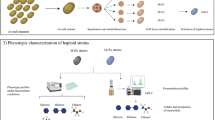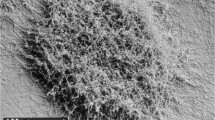Abstract
THE cellular slime mould Dictyostelium discoideum is a unicellular organism in its vegetative stage. On starvation, slime mould amoebae gather into aggregates which pass through a morphogenesis culminating in mature fruiting bodies consisting of dead stalk cells supporting a sphere of viable spores1. The laboratory strains of D. discoideum are normally haploid, and the genetic techniques available to study cellular differentiation are based on a parasexual system of analysis which includes selection of temperature-resistant diploids after fusion of two haploid strains bearing complementing temperature-sensitive mutations. Recovery of rare haploid segregants is accomplished by selecting recessive drug resistance markers incorporated into one of the parents2. The parasexual system suffers from a dearth of selectable markers. The creation of a defined minimal medium3 has made possible the isolation of auxotrophic mutants which we describe here. These auxotrophs should improve linkage analysis by increasing the number of selectable genetic loci and should also prove useful for the selection of diploids and for a variety of biochemical purposes.
This is a preview of subscription content, access via your institution
Access options
Subscribe to this journal
Receive 51 print issues and online access
$199.00 per year
only $3.90 per issue
Buy this article
- Purchase on Springer Link
- Instant access to full article PDF
Prices may be subject to local taxes which are calculated during checkout
Similar content being viewed by others
References
Bonner, J. T. The Cellular Slime Molds, 2nd edn (Princeton University Press, 1967).
Newell, P. C., Henderson, R F., Moses, D. & Ratner, D. I. J. gen. Microbiol. 100, 207–211 (1977).
Franke, J. & Kessin, R. H. Proc. natn. Acad. Sci. U.S.A. 74, 2157–2161 (1977).
Kessin, R. H., Williams, K. L. & Newell, P. C. J. Bact. 119, 776–783 (1974).
Sussman, M. Meth. Cell Physiol. 2, 397–410 (1966).
Brenner, M., Tisdale, D. & Loomis, W. F., Jr. Exp. Cell Res. 90, 249–252 (1975).
Kent, R. J., Lin, R. L., Sallach, H. J. & Cohen, P. P. Proc. natn. Acad. Sci. U.S.A. 72, 1712–1716 (1975).
Jarry, B. FEBS Lett. 70, 71–75 (1976).
Lowry, O. H., Rosebrough, N. J., Farr, A. L. & Randall, R. J. J. biol. Chem. 193, 265–275 (1951).
Author information
Authors and Affiliations
Rights and permissions
About this article
Cite this article
FRANKE, J., KESSIN, R. Auxotrophic mutants of Dictyostelium discoideum. Nature 272, 537–538 (1978). https://doi.org/10.1038/272537a0
Received:
Accepted:
Issue Date:
DOI: https://doi.org/10.1038/272537a0
This article is cited by
-
Positive selection for Dictyostelium discoideum mutants lacking UMP synthase activity based on resistance to 5-fluoroorotic acid
Molecular and General Genetics MGG (1991)
-
A DNA sequence from Dictyostelium discoideum complements ura3 and ura5 mutations of Saccharomyces cerevisiae
Molecular and General Genetics MGG (1984)
Comments
By submitting a comment you agree to abide by our Terms and Community Guidelines. If you find something abusive or that does not comply with our terms or guidelines please flag it as inappropriate.



